同济大学:《给水工程原理与技术》课程电子教案(课件讲稿)Advanced Oxidation
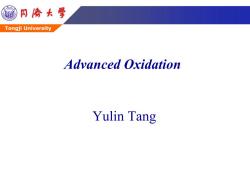
同©大学 Tongji University Advanced Oxidation Yulin Tang
Tongji University Advanced Oxidation Yulin Tang
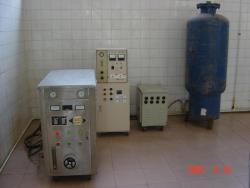
0 ● 8888 2003819
Tongji University
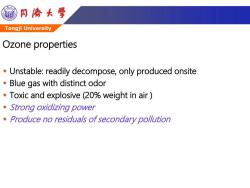
同©大学 Tongji University Ozone properties Unstable:readily decompose,only produced onsite Blue gas with distinct odor Toxic and explosive(20%weight in air Strong oxidizing power Produce no residuals of secondary pollution
Tongji University Ozone properties Unstable: readily decompose, only produced onsite Blue gas with distinct odor Toxic and explosive (20% weight in air ) Strong oxidizing power Produce no residuals of secondary pollution
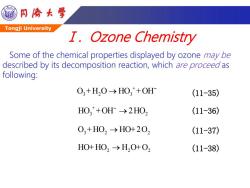
同海大学 Tongji University I.Ozone Chemistry Some of the chemical properties displayed by ozone may be described by its decomposition reaction,which are proceed as following: O3+H20→HO3+OH (11-35) HO3+OH→2HO2 (11-36) 03+H02→H0+20, (11-37) H0+H02→H2O+O2 (11-38)
Tongji University Ⅰ. Ozone Chemistry Some of the chemical properties displayed by ozone may be described by its decomposition reaction, which are proceed as following: + O + H O HO + OH 3 2 3 + HO + OH 2HO 3 2 O + HO HO+ 2O 3 2 2 HO+ HO H O+ O 2 2 2 (11-35) (11-36) (11-37) (11-38)
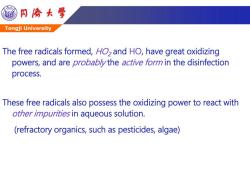
同海大学 Tongji University The free radicals formed,H0,and HO,have great oxidizing powers,and are probab/y the active form in the disinfection process. These free radicals also possess the oxidizing power to react with other impurities in aqueous solution. (refractory organics,such as pesticides,algae)
Tongji University The free radicals formed, HO2 and HO, have great oxidizing powers, and are probably the active form in the disinfection process. These free radicals also possess the oxidizing power to react with other impurities in aqueous solution. (refractory organics, such as pesticides, algae)
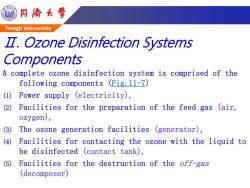
同燎大学 Tongji University II.Ozone Disinfection Systems Components A complete ozone disinfection system is comprised of the following components (Fig.11-7) (1) Power supply (electricity), (2) Facilities for the preparation of the feed gas (air, oxygen), (3) The ozone generation facilities (generator), (4) Facilities for contacting the ozone with the liquid to be disinfected (contact tank), (5) Facilities for the destruction of the off-gas (decomposer)
Tongji University Ⅱ. Ozone Disinfection Systems Components A complete ozone disinfection system is comprised of the following components (Fig.11-7) (1) Power supply (electricity), (2) Facilities for the preparation of the feed gas (air, oxygen), (3) The ozone generation facilities (generator), (4) Facilities for contacting the ozone with the liquid to be disinfected (contact tank), (5) Facilities for the destruction of the off-gas (decomposer)
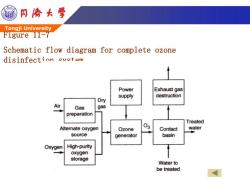
G 同©大号 Tongji University Figure 11-7 Schematic flow diagram for complete ozone disinfection evetom Power Exhaust gas supply destruction Dry Air Gas gas preparation Treated Alternate oxygen Ozone Contact water source generator basin Oxygen High-purity oxygen storage Water to be treated
Tongji University Figure 11-7 Schematic flow diagram for complete ozone disinfection system
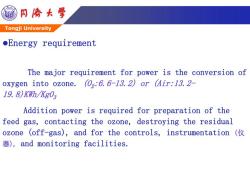
同©大学 Tongji University ●Energy requirement The major requirement for power is the conversion of oxygen into ozone.(02:6.6-13.2)or (Air:13.2- 19.8)KWh/Kg03 Addition power is required for preparation of the feed gas,contacting the ozone,destroying the residual ozone (off-gas),and for the controls,instrumentation 器),and monitoring facilities
Tongji University Energy requirement The major requirement for power is the conversion of oxygen into ozone. (O2:6.6-13.2) or (Air:13.2- 19.8)KWh/KgO3 Addition power is required for preparation of the feed gas, contacting the ozone, destroying the residual ozone (off-gas), and for the controls, instrumentation (仪 器), and monitoring facilities
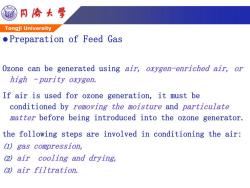
同傍大学 Tongji University Preparation of Feed Gas Ozone can be generated using air,oxygen-enriched air,or high -purity oxygen. If air is used for ozone generation,it must be conditioned by removing the moisture and particulate matter before being introduced into the ozone generator. the following steps are involved in conditioning the air: (1) gas compression, (2) air cooling and drying, (3) air filtration
Tongji University Preparation of Feed Gas Ozone can be generated using air, oxygen-enriched air, or high –purity oxygen. If air is used for ozone generation, it must be conditioned by removing the moisture and particulate matter before being introduced into the ozone generator. the following steps are involved in conditioning the air: (1) gas compression, (2) air cooling and drying, (3) air filtration
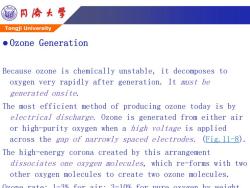
同傍大学 Tongji University ●Ozone Generation Because ozone is chemically unstable,it decomposes to oxygen very rapidly after generation.It must be generated onsite. The most efficient method of producing ozone today is by electrical discharge.Ozone is generated from either air or high-purity oxygen when a high voltage is applied across the gap of narrowly spaced electrodes.(Fig.11-8). The high-energy corona created by this arrangement dissociates one oxygen molecules,which re-forms with two other oxygen molecules to create two ozone molecules
Tongji University Ozone Generation Because ozone is chemically unstable, it decomposes to oxygen very rapidly after generation. It must be generated onsite. The most efficient method of producing ozone today is by electrical discharge. Ozone is generated from either air or high-purity oxygen when a high voltage is applied across the gap of narrowly spaced electrodes. (Fig.11-8). The high-energy corona created by this arrangement dissociates one oxygen molecules, which re-forms with two other oxygen molecules to create two ozone molecules. Ozone rate: 1-3% for air; 3-10% for pure oxygen by weight
按次数下载不扣除下载券;
注册用户24小时内重复下载只扣除一次;
顺序:VIP每日次数-->可用次数-->下载券;
- 同济大学:《给水工程原理与技术》课程电子教案(课件讲稿)Municipal Water Purification Plant.pdf
- 同济大学:《给水工程原理与技术》课程电子教案(课件讲稿)Membrane technology.pdf
- 同济大学:《给水工程原理与技术》课程电子教案(课件讲稿)Filtration.pdf
- 同济大学:《给水工程原理与技术》课程电子教案(课件讲稿)Sedimentation.pdf
- 同济大学:《固体废物处理与资源化》课程教学资源(讲稿)Leachate and Landfill Gas.pdf
- 同济大学:《固体废物处理与资源化》课程教学资源(讲稿)Incineration, pyrolysis & gasification.pdf
- 同济大学:《固体废物处理与资源化》课程教学资源(讲稿)Biogas – a way to solve sanitation problems.pdf
- 同济大学:《固体废物处理与资源化》课程教学资源(讲稿)Waste processing technologies application.pdf
- 同济大学:《固体废物处理与资源化》课程教学资源(讲稿)Introduction on Solid Waste.pdf
- 《固体废物处理与资源化》课程教学资源(文献资料)LANDFILL MANUALS LANDFILL SITE DESIGN.pdf
- 《固体废物处理与资源化》课程教学资源(文献资料)The anaerobic digestion process of biogas production from food waste - Prospects and constraints.pdf
- 《固体废物处理与资源化》课程教学资源(文献资料)Efficient reduction of antibiotic residues and associated resistance genes in tylosin antibiotic fermentation waste using hyperthermophilic composting.pdf
- 《固体废物处理与资源化》课程教学资源(文献资料)A feasibility assessment of an integrated plastic waste system adopting.pdf
- 长沙理工大学:《环境监测》课程教学资源(课件讲稿,打印版)第9章 环境监测质量保证.pdf
- 长沙理工大学:《环境监测》课程教学资源(课件讲稿,打印版)第5章 土壤质量监测 Soil Pollution Monitoring.pdf
- 长沙理工大学:《环境监测》课程教学资源(课件讲稿,打印版)第3章 大气和废气监测 Atmosphere and flue waste gas monitoring.pdf
- 长沙理工大学:《环境监测》课程教学资源(课件讲稿,打印版)第2章 水和废水监测.pdf
- 长沙理工大学:《环境监测》课程教学资源(实验指导,打印版)实验8 生化需氧量的测定.pdf
- 长沙理工大学:《环境监测》课程教学资源(实验指导,打印版)实验7 化学需氧量的测定.pdf
- 长沙理工大学:《环境监测》课程教学资源(实验指导,打印版)实验5 碘量法测定水中溶解氧.pdf
- 同济大学:《给水工程原理与技术》课程电子教案(课件讲稿)Mixing Coagulation - Flocculation.pdf
- 同济大学:《水资源管理》课程教学资源(教案讲义)01 Introduction to water resources(负责人:王洪涛).pdf
- 同济大学:《水资源管理》课程教学资源(教案讲义)02 Water Resources Management Tool - Water Footprint(WF).pdf
- 同济大学:《水资源管理》课程教学资源(教案讲义)03 Energy-water nexus in urban water systems.pdf
- 同济大学:《水资源管理》课程教学资源(教案讲义)04 Water Quality Modeling、Reactions & Transport、Dissolved Oxygen Modeling in Rivers、Eutrophication.pdf
- 同济大学:《水资源管理》课程教学资源(教案讲义)05 Trans-boundary water resources management.pdf
- 同济大学:《水资源管理》课程教学资源(教案讲义)06 Water Resource Management - Sponge City.pdf
- 同济大学:《水资源管理》课程教学资源(教案讲义)08 Case in Lake Victoria, East Africa.pdf
- 同济大学:《水资源管理》课程教学资源(教案讲义)07 Brief Introduction to Integrated Water Environment Rehabilitation、A Big Picture:China City’s Effort to Improve River Water Quality with Shanghai as a Case、River water quality assessment and water pollution sources survey.pdf
- 上海海洋大学:海洋生态与环境学院课程教学大纲汇编(2018版).pdf
- 兰州交通大学:《环境保护与可持续发展》课程教学资源(大纲讲义)教学大纲 Environmental protection and sustainable development.pdf
- 兰州交通大学:《环境保护与可持续发展》课程教学资源(试卷习题)试卷1.doc
- 兰州交通大学:《环境保护与可持续发展》课程教学资源(试卷习题)试卷2.doc
- 兰州交通大学:《环境保护与可持续发展》课程教学资源(试卷习题)试卷3.doc
- 兰州交通大学:《环境保护与可持续发展》课程教学资源(试卷习题)试卷4.doc
- 兰州交通大学:《环境保护与可持续发展》课程教学资源(试卷习题)试卷5.doc
- 兰州交通大学:《环境保护与可持续发展》课程教学资源(授课教案)第一章 地球环境的基本特征.doc
- 兰州交通大学:《环境保护与可持续发展》课程教学资源(授课教案)第二章 生态系统.doc
- 兰州交通大学:《环境保护与可持续发展》课程教学资源(授课教案)第三章 人口与资源.doc
- 兰州交通大学:《环境保护与可持续发展》课程教学资源(授课教案)第四章 资源短缺.doc
